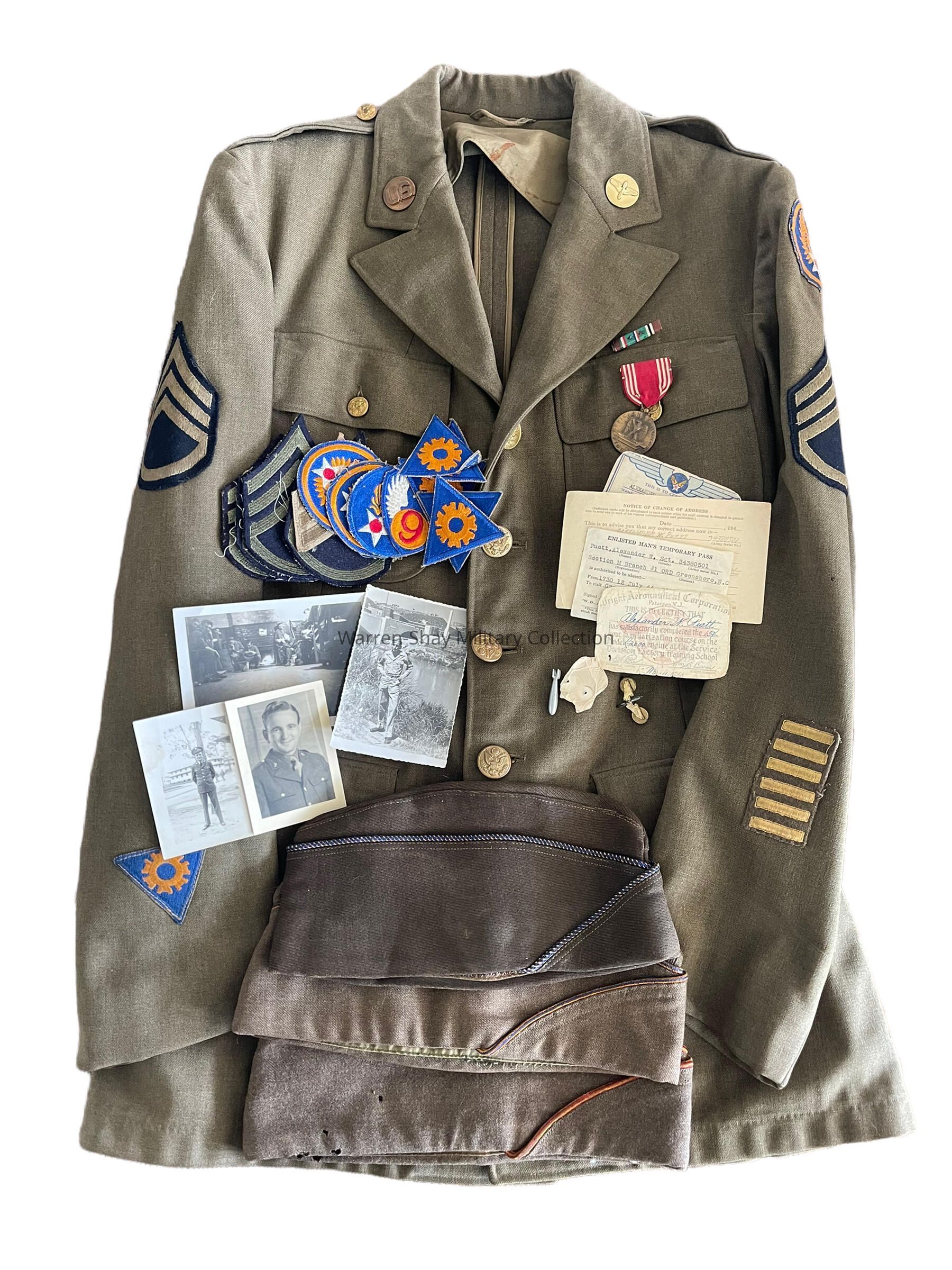Name/Title
Alexander W. Puett USAAF UniformEntry/Object ID
Uniform2022.20Description
Alexander Walsh Puett
Staff Sergeant
ASN: 34380501
Aircraft Maintenance Technician
609th Bomb Squadron
400th Bomb Group
Enlisted: July 31, 1942
Place of Induction: Fort Jackson, South Carolina
Date of Separation: November 19, 1945
Place of Separation: Separation Center, Fort Bragg, North Carolina
Place of Birth: Dallas, North Carolina
Date of Birth: August 21, 1920
Reason for Separation: Convenience of the Government (Demobilization)
Alexander enlisted in in Fort Jackson, S.C. on July 31, 1942. Prior to his service he was a Livestock Speculator, predicting the meat market direction and optimal time to buy and sell for farmers. He entered into active service on August 14, 1942. He attended basic training, qualifying with the M1 Carbine and went to Kessler Field in April of 1943 for Aircraft Mechanic school. While attending school, he completed a 154 hour familiarization course on the Model R-2600 engine. The R-2600 Engine was a 14 cylinder supercharged air-cooled two-row radial engine. It saw use in a variety of aircraft including the Douglas A-20 Havoc, Douglas B-23 Dragon, Grumman F6F Hellcat, Grumman TBF Avenger, Martin 187 Baltimore, Martin PBM Mariner and North American B-25 Mitchell.
On August 9, 1944, Alexander was sent the European-African-Middle Eastern Theater of Operations and arrived on August 21, 1944. While in theater, Alex was assigned to the 71st Fighter Squadron and was credited with six bronze service stars. He participated in the Rome-Arno, North Appennines, PO Valley, Northern France, Rhineland and Balkans (Air Combat) Campaigns. While his exact movement and service remains unknown, it can be speculated that Mr. Puett spent time either filling in as a Flight Engineer or was on a test flight to receive a bronze service star for air combat.
The 71st Fighter Squadron is listed as being stationed in the following areas pursuant with his credited participation stars.
Salsola Airfield, Italy, 9 January 1944
Detachment operated from: Aghione, Corsica, 11–21 August 1944
Detachment operated from: Vincenzo Airfield, Italy, 10 Jan – 18 February 1945
Lesina Airfield, Italy, 14 March 1945
Marcianise, Italy, 26 September 1845 – 16 October 1945
A short outline of the 71st from militaryaircrafthistorian.com can be found below:
"Training began with the Seversky P-35 and later the Republic YP-43 Lancer (precursor to the P-40 Thunderbolt). In 1941 they were redesignated the 71st Pursuit Squadron (Fighter).
Two days after the attack on Pearl Harbor, the squadron reported to San Diego NAS to help defend the Southern California coast. Just two months later, the squadron relocated to Los Angeles where they began flying the Lockheed P-38 Lightning. They were renamed the 71st Fighter Squadron.
In June of 1942, the squadron became the first single-seat, twin engine fighter unit to deploy to England during World War II. December of 1942 saw their first combat kill when Capt John D. Eiland downed a Focke-Wulf 190.
The squadron distinguished itself in the European theater with 102 combat kills and produced 5 aces. With the war in Europe over, the squadron was deactivated in October, 1945."
Alex was sent home to the United States on November 25, 1945 (according to Discharge). His awards include the American Theater Campaign Medal, European Theater of Operations Medal with 6 bronze service stars, Good Conduct Medal and Victory Medal.
The uniform was purchased on ebay directly from his son. All items that are shown is what was purchased.Provenance
Notes
purchased from son who provided additional photos, patches-free of charge. discharge found on ancestry.Create Date
August 24, 2022Update Date
May 6, 2025
